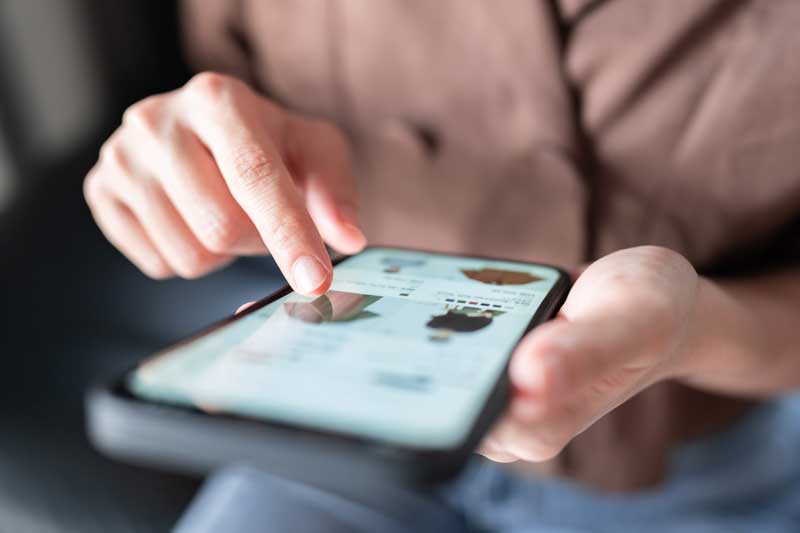
Consumers are increasingly demanding, and competition is fierce, so the customer experience has become a key differentiating factor for retailers. Physical stores are not immune to this trend, and must adapt to offer a memorable and engaging shopping experience. This is where technology comes into play, enabling retailers to personalize the customer experience, increase engagement and, ultimately, boost sales.
According to a study conducted by Capgemini in 2022, 81% of French consumers attach great importance to the in-store experience when making a purchase [1]. However, only 32% say they are satisfied with the experience currently on offer [1]. This gap highlights the need for retailers to invest in innovative solutions to improve the customer experience.
What’s more, a study conducted by Salesforce in 2021 reveals that 66% of French consumers are willing to pay a higher price for better service and a superior shopping experience [2]. This statistic underlines the crucial importance of the customer experience in a store’s business strategy.
In-store customer experience refers to all the emotions, perceptions and interactions experienced by a customer when visiting a physical store, from the moment they arrive until they leave. It encompasses various aspects and stages, such as welcome, orientation, product discovery, fitting, advice, payment, loyalty, after-sales service, etc… The in-store customer experience is a major challenge for retailers, as it determines customer satisfaction, loyalty and recommendation, and therefore the store’s long-term performance and sustainability.
The customer journey is a complex, dynamic and constantly evolving process, broken down into several key stages.
This is an essential phase, during which the customer becomes aware of a lack or difficulty and seeks to remedy it.
The customer evaluates the various options and solutions available on the market, based on criteria such as quality, price, reputation and correlation with the customer’s needs.
During this stage, the customer selects the solution best suited to his or her needs, and proceeds with the purchase. Businesses that stand out from the crowd, particularly in terms of customer experience, are most likely to be chosen during this stage.
This is where customers evaluate the conformity and satisfaction of their purchase. This is the phase during which the customer is likely to leave an opinion, positive or negative; it is therefore very important.
This stage, especially in the event of a problem, is absolutely vital to the store’s long-term success. The customer receives guidance and support in using and repairing the product or service.
If all the above steps are properly managed by the retailer, there’s a good chance that customers will renew their commitment to the brand and share their positive experience with others.
The major challenges of the in-store customer experience are multiple and interdependent. First and foremost, it’s essential to capture customers’ attention and arouse their interest as soon as they enter the store. Next, it’s important to accompany and guide them throughout their purchasing journey, providing them with relevant information and responding to their questions and concerns. Personalizing the shopping experience according to customers’ individual preferences and needs is also a major challenge, as it enhances their satisfaction and commitment.
Ensuring a smooth, frictionless shopping experience, reducing waiting times and facilitating transactions and returns, guarantees a significantly improved customer experience.
Customer satisfaction is a key factor in the success of a business, as it determines customer loyalty and referrals, as well as growth and profitability. Several concepts are essential to understanding and measuring customer satisfaction.
First of all, it’s important to distinguish between objective satisfaction, which is based on a rational assessment of the quality and value of products and services, and subjective satisfaction, which is influenced by emotions, expectations and past experiences.
Different levels of satisfaction must then be taken into account: total dissatisfaction, full satisfaction, partial satisfaction, neutrality.
Finally, it’s crucial to regularly measure customer satisfaction using reliable, relevant indicators such as the Net Promoter Score (NPS), Customer Satisfaction Score (CSAT) and Customer Effort Score (CES).
A good customer experience is based on a number of key factors, which companies need to take into account and optimize.
The quality and value of the products and services on offer are a top priority, as they determine objective customer satisfaction.
The emotional and sensory experience that customers have throughout their purchasing journey is also a determining factor, as it influences their subjective satisfaction and unconscious memory of the experience. Personalizing the shopping experience according to customers’ individual preferences and needs makes for a highly enjoyable emotional experience, and significantly boosts satisfaction and engagement rates.
Last but not least, the fluidity and simplicity of the purchasing process, as well as the quality and responsiveness of customer service, are factors that must not be overlooked to guarantee an exceptional customer experience.
Emerging technologies offer numerous opportunities for optimizing the in-store customer experience. Here are just a few examples.
Augmented reality (AR) is a technology that superimposes virtual elements on the real world, in real time and to scale. In retail, AR offers numerous possibilities and applications for enhancing the in-store customer experience, particularly for products that require a trial or visualization before purchase, such as clothing, eyewear, furniture or cosmetics.
Thanks to AR, customers can virtually try on products on their own bodies or in their own environment, simply by using their smartphone or a tablet made available in-store. They can thus visualize and compare different styles, colors and sizes, and get a more accurate and realistic idea of the final rendering, without having to undress or move furniture. What’s more, they can benefit from personalized advice and recommendations, based on their morphology or tastes.
According to a Gartner study, 100 million consumers will be using AR to make purchases by 2024, testifying to the interest and potential of this technology for retail and distribution. Many stores and brands have already adopted AR to enhance the in-store customer experience.
Interactive screens are digital devices that make it easier for customers to browse product catalogs, view detailed information (features, reviews, prices, etc.) and place orders very quickly from the screen, using gestures or tactile keys.
Interactive screens thus offer an immersive, innovative, fun and personalized shopping experience, enabling customers to discover and choose the products that best suit their needs, desires and budget.
What is more, interactive screens enable retailers to showcase their products and values, by offering rich and varied content (videos, photos, text, etc.), and to collect and analyze massive amounts of valuable data on customer preferences and behaviors. As a result, interactive screens are increasingly used in stores, shopping malls, airports and railway stations, to enhance customer experience and sales performance.
Customers can now pay for their purchases quickly and easily using their bankcard, smartphone or e-purse at automatic pay stations. They are becoming increasingly popular in stores, restaurants, parking lots and public transport systems, making transactions more fluid and secure, and reducing waiting times and queues at traditional checkouts.
For customers, the gain in time and autonomy in their purchasing process is invaluable. They benefit from a variety of payment methods adapted to their habits, and reduce the risk of fraud or error.
For retailers, this means a significant increase in sales and productivity, and a reduction in the costs and constraints associated with managing cash and payment terminals.
Facial recognition is a technology that identifies and recognizes customers’ faces, using algorithms and databases. In the retail sector, facial recognition can be used to enhance the in-store customer experience, providing personalized offers and services tailored to each individual customer.
Facial recognition solutions are usually installed at the store entrance, in the form of cameras or interactive kiosks. When the customer enters the store, his or her face is automatically recognized and identified, thanks to a comparison with a previously created and consented database. Customers can then benefit from a personalized, privileged shopping experience, based on their profile, habits and expectations.
For example, they can receive a welcome message and a discount offer on their favorite product, on their smartphone or on a dedicated screen. They can also be guided and guided to the departments or products that best suit them, based on their purchase history or areas of interest. They can also benefit from personalized advice and recommendations, based on their profile and needs.
Mobile applications can be used to enhance the in-store customer experience, offering useful and innovative services and functionalities that enable customers to better prepare, experience and prolong their shopping experience.
In concrete terms, mobile applications can offer customers numerous possibilities and benefits, depending on their needs and expectations. For example, customers can :
Thanks to mobile applications, retailers are in constant contact with their customers, making it much easier to promote products that are highly targeted to them.
Virtual assistants are software programs that can interact and communicate with customers, using speech recognition and synthesis, natural language processing and artificial intelligence technologies. By offering useful and innovative services and functionalities, virtual assistants enable customers to enhance and extend their shopping experience.
Thanks to this innovative in-store technology, customers can :
Virtual assistants are a considerable asset for retailers, enabling them to remain competitive over the long term.
However, all these technologies also raise ethical and legal questions and issues, particularly as regards respect for privacy and personal data. Retailers wishing to implement them in their stores must therefore ensure that they comply with the rules and best practices in force, and that they inform and obtain the prior consent of their customers.
The adoption of these technologies has a direct impact on retailers’ sales. According to a study by Harvard Business Review, companies that excel in customer experience generate on average 5.7 times more revenue than their competitors.
What’s more, a study by Forrester Research in 2021 reveals that stores that invest in customer experience enjoy a customer loyalty rate 5.1 times higher than those that don’t.
Several stores have already successfully adopted these technologies, demonstrating their positive impact on customer experience and sales.
Sephora, the famous cosmetics chain, has introduced interactive screens in its stores, enabling customers to virtually try on make-up products thanks to augmented reality. This initiative contributed to a 15% increase in in-store sales.
Zara, the Spanish ready-to-wear retailer, has deployed automatic payment terminals in its stores, reducing waiting times at checkouts. This strategy has improved customer satisfaction and boosted sales by 8% in one year.
Food retail giant Carrefour has launched a mobile application enabling customers to scan products in-store and access detailed information, promotions and personalized recommendations. This initiative led to a 12% increase in the average shopping basket.
To take full advantage of emerging technologies and optimize the in-store customer experience, companies need to adopt a strategic approach and follow the recommendations below.
Identify specific customer experience challenges and define measurable objectives to evaluate the success of initiatives.
Collect and analyze data on customer behavior, preferences and expectations to personalize the shopping experience.
Ensure that sales teams are properly trained to use new technologies effectively and deliver an exceptional customer experience.
Inform customers about new technologies and the benefits they bring to their shopping experience.
Regularly monitor customer experience KPIs and adjust strategies accordingly.
Optimizing the in-store customer experience through technology has become a necessity for stores wishing to remain competitive in an ever-changing retail environment. Emerging technologies such as augmented reality, interactive screens, automatic payment terminals, facial recognition, mobile applications and virtual assistants offer numerous opportunities to personalize the shopping experience, increase customer engagement and, ultimately, boost sales.
However, to take full advantage of these technologies, companies need to adopt a strategic approach, clearly defining their objectives, analyzing customer data, training their teams, communicating effectively with their customers and regularly measuring results to adjust their strategies.
In the future, we can expect emerging technologies to continue to evolve and offer new possibilities for enhancing the in-store customer experience. Artificial intelligence, the Internet of Things (IoT) and blockchain are all promising technologies that could revolutionize the retail sector in the years to come.
Inibar Services, with its recognized expertise in innovative technologies, is the ideal partner to support stores in their digital transformation and enable them to optimize the in-store customer experience. Thanks to its team of qualified experts and tailor-made approach, Inibar Services can help companies implement the best technological solutions to meet their specific needs and achieve their business objectives.
[1] Capgemini, “The Disconnected Customer Experience” (2022)
[2] Salesforce, “State of the Connected Customer” (2021)
[3] Forbes, “How Augmented Reality Is Transforming Retail” (2022)
[4] Gartner, “Top Strategic Technology Trends for 2023” (2022)
[5] Retail TouchPoints, “Interactive Displays Enhance the In-Store Experience” (2021)
Retail Dive, “Self-Checkout Kiosks Improve Customer Experience” (2022)
Harvard Business Review, “How Facial Recognition Is Changing Retail” (2021)
Invesp, “Mobile Apps for Retail: Improving the In-Store Experience” (2022)
Forrester, “The Future of AI in Retail” (2021)
Harvard Business Review, “The Value of Customer Experience, Quantified” (2020)
Forrester, “The Total Economic Impact of Customer Experience Transformation” (2021)
Sephora, “Sephora Unveils New Augmented Reality Experience” (2021)
Zara, “Zara Implements Self-Checkout Kiosks” (2022)
Carrefour, “Carrefour Launches New Mobile App” (2021)
[1] https://www.href.fr/top-10-des-experts-en-digital-marketing-sur-linkedin/
[2] https://fr.linkedin.com/pulse/ecrire-et-publier-des-articles-linkedin-ne-sert-plus-%C3%A0-depernet
[3] https://clementine-hedont.fr/entrepreneur-8-conseils-pour-publier-sur-linkedin-et-faire-decoller-son-business/
[4] https://fr.linkedin.com/posts/trupheme_%C3%A0-quoi-sert-vraiment-le-content-marketing-activity-7184085215156293632-f93l
[5] https://fr.linkedin.com/pulse/comment-utiliser-efficacement-ton-profil-linkedin-pour-payotte-4087e
Consumers are increasingly demanding, and competition is fierce, so the customer experience has become a key differentiating factor for retailers…


